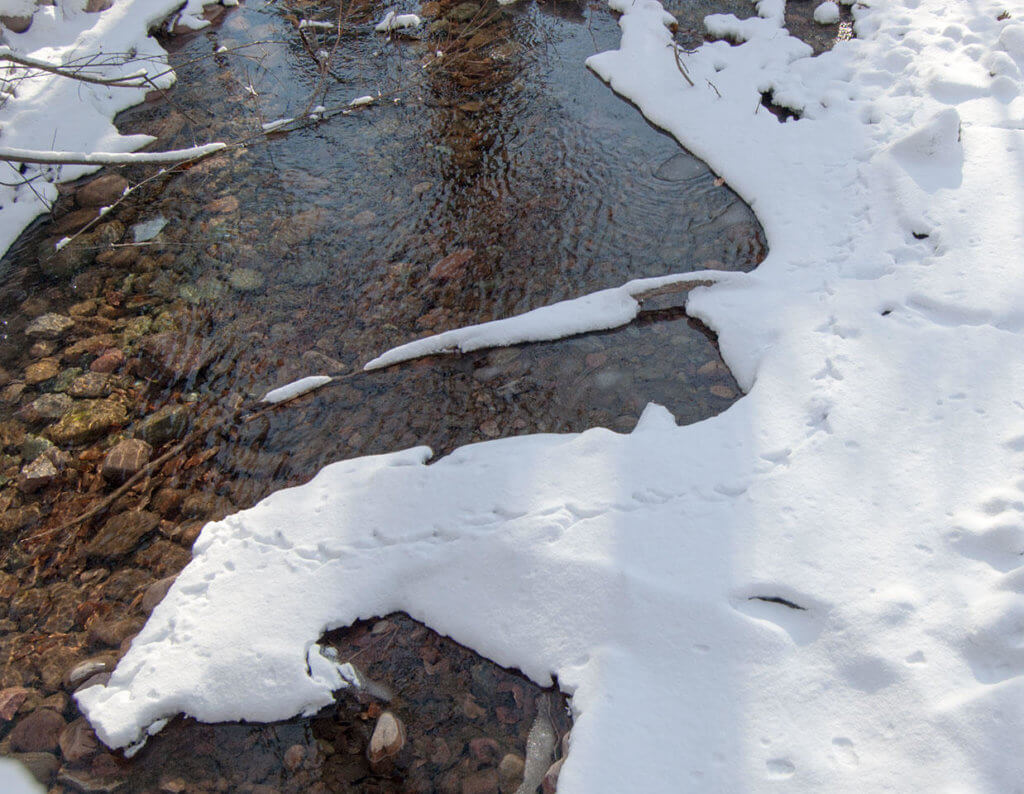Wildlife Stories Cast in Snow
by Deborah Richie Oberbillig
Broadcast 1.1 and 1.5.2017

Heron tracks in snow. Photo by Josh Burnham.
Listen:
Skiing across fresh fallen snow through a Ponderosa forest, I pause at strange tracks with no apparent beginning or end, as if some animal had fallen from the sky. Wing tracings reveal a delicate brush of feathers. Within a heavy indentation where the bird must have struck, the snow is stained slightly red. The wingspread measures almost as long as my outstretched arms.
Imagine the night before, when a Great Horned Owl swooped upon a deer mouse with talons outstretched. In one fierce grasp, the bird lifted its prey and flew off again on muffled wings. Crouching down to study the scene more carefully, I find the faint, hopping tracks of this mouse or vole leading directly to the end of its life.
Winter is the best season to hone tracking skills, especially this year when the snow never seems to melt anywhere in Montana. The snow bears stories of wildlife drama and the daily trudge of survival. Along a river, beavers forge channeled snow trails from favorite cottonwood trees to the icy waters. Their logging operation leaves a bounty of evidence, from the chewed trees and wood chips to the drag marks of their flat tails and large branches. Look for elongated, webbed tracks that usually reveal three or five toes. Their paws are flippers too, perfect for strong swimmers who bear heavy loads.
In my backyard, three-pronged tracks below the bird feeder form a pattern as unreadable and lovely to see as Chinese lettering. Superimposed on bird tracks are the paw prints of gray squirrels and that story of unending competition for seeds.
To become a wildlife tracker requires the persistence of a detective. A single track is not enough. A whole trail pattern is better. And then, there are many factors to consider. What size are the tracks and what is the distance between them? Did the hind feet precede the front feet in landing? Did warming temperatures melt some of the tracks, causing them to widen? Are all the toes actually visible? Did the trail pattern change from a walk to a run?
Even with Olaus J. Murie’s A Field Guide to Animal Tracks and a ruler in hand, it helps to know generally the wildlife inhabiting the area to eliminate some choices immediately. Another book useful for breaking mysterious codes in the snow is Tracking and the Art of Seeing by Paul Rezendes.
To discover wildlife stories cast in snow takes an awareness of the entirety of our landscape and an ability to focus on what’s near at hand, and often subtle.
Every week since 1991, Field Notes has inquired about Montana’s natural history. Field Notes are written by naturalists, students, and listeners about the puzzle-tree bark, eagle talons, woolly aphids, and giant puffballs of Western, Central and Southwestern Montana and aired weekly on Montana Public Radio.
Click here to read and listen to more Field Notes. Field Notes is available as a podcast! Subscribe on iTunes, Google Play, or wherever you listen to podcasts.
Interested in writing a Field Note? Contact Allison De Jong, Field Notes editor, at adejong [at] montananaturalist [dot] org or 406.327.0405.
Want to learn more about our programs as well as fun natural history facts and seasonal phenology? Sign up for our e-newsletter! You can also become a member and get discounts on our programs as well as free reciprocal admission to 300+ science centers in North America!












